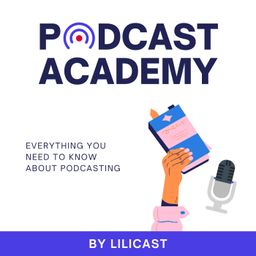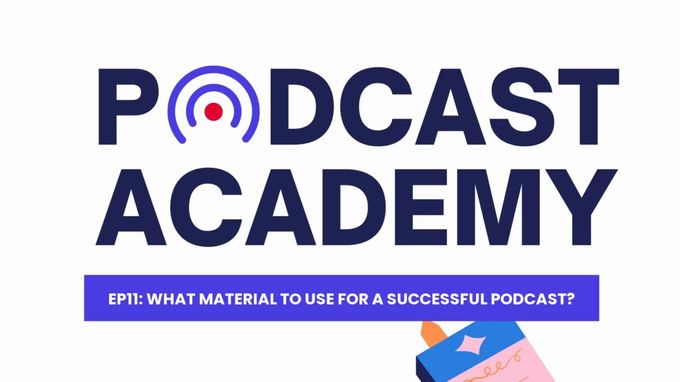
11 - What material to use for a successful podcast?

Chapters






















Description
(00:00:00) INTRO The number one fear of many people starting a podcast: financial investment. Let me reassure you right away. Making a podcast doesn't cost a lot of money... Especially if you subscribe to Lilicast. You do not need much, besides a computer to record your podcast. You can, in fact, already start using the microphone of your mobile phone or a headset. The sound will be quite satisfactory. Not perfect, but quite acceptable. However, never use the built-in microphone of your computer. The result will be inaudible. If you want to take the sound quality up a notch, it will be hard to choose. And that can leave you with many choices: But how can you make a choice when you know nothing about it??? (00:00:45) DYNAMIC MICROPHONE Let's move to the simplest and most obvious. There are two types of microphones: dynamic and condenser, each with its own characteristics, as you can imagine. Do not dig too much into the complicated technical side, be aware that dynamic microphones are less fragile but less sensitive than condenser microphones. This means that you need to get closer to the microphones. Your mouth should stay close to the microphone. To give you an idea, the dynamic microphone is the one we use in radio and also the one that a singer uses on stage. The advantage of dynamic microphones is that they are all-terrain, robust, and inexpensive. The inconvenience is that only one person can use the microphone at the same time as you have to stay close to the microphone as you speak. So, you cannot really gesticulate. As soon as you move away or turn your head, you will be able to hear it. (00:01:42) CONDENSER MICROPHONES Condenser microphones are more technologically advanced than dynamic microphones. They will therefore pick up sound more accurately. Your voice will be emphasized, but the slightest unusual mouth noise will be heard more than with a dynamic microphone. The sensitivity of the condenser microphone requires a very quiet environment. While the dynamic microphone is preferred on stage, the condenser microphone is the one used by a singer in the studio. One of the advantages of condenser microphones is their high sensitivity, which allows them to capture the subtle nuances of sound. But they are expensive and fragile mics. (00:02:22) ACCESSORIES Once you have the microphone, you will need a microphone stand and a windscreen or pop filter. Some mics are sold in a small case with these useful accessories. So once you have the mic, where do you plug it in? Again, it depends... (00:02:38) XLR OR USB The cheapest version will be the micro USB. USB microphones are easier to use as a beginner. You plug the microphone directly into your computer, it converts the audio signal into a digital signal, and you can immediately record your voice. The USB microphone is very practical when you are the only one talking. Just plug it in and off you go. With several people, it gets a little more complicated. Your computer will recognise only one microphone. If you don't want to bother getting an external sound card and if you want to stick to a low budget, we advise you to choose an omnidirectional condenser USB microphone. On the Lilicast blog, you can find information about the Blue Yeti multipurpose microphone. It costs less than 150 euros and comes with a little stand and a pop filter. It has four different sound pickup patterns and among them, the omnidirectional one, to record discussions of several people around a table. (00:03:41) If you have a bigger budget and want better sound quality, you can go for a microphone with an XLR connector. These are the ones that the pros use. The XLR connector must be plugged into an external sound interface that is connected to your computer. If you invest in a microphone with an XLR connector you will have to buy an external audio interface, also called a sound card. So, of course, it will be more expensive. The microphone with XLR connector allows you to record multiple speakers. The sound card has several inputs, so you can record several sound sources at the same time. Since sound cards allow live adjustments during recording, the sound is often better than with a USB microphone. The big disadvantage is that you need a microphone for each speaker, so again, it will be more expensive. (00:04:31) HEADPHONES Another investment to make: headphones. You absolutely have to listen to yourself. Even if you are not alone. Especially if you are not alone. Because there's nothing more annoying than recording an interview only to find out at the end that nothing worked or that there's unbearable noise throughout your recording. Choose closed-back headphones so you can only hear the sound captured. (00:04:56) RECAP Let me recap. In addition to your computer, you have two options. For a low-budget package, opt for a USB microphone, or even an omnidirectional USB microphone, so that you can adapt to all situations. We recommend the Rode nt mini, a USB condenser microphone with headphone output, for less than 100 euros. It is perfect for recording alone. For a group podcast, the Blue Yeti can be used. With omnidirectional and USB, you can do group recordings or solo. If money is not an issue or if it's either too pro or nothing at all, go for an XLR mic with sound card. For the sound card, go for Focusrite and for the Shure MS7 microphone or the Rode Podcaster. If you choose this option and you are doing a group podcast, remember that you will need as many mics and XLR plugs as the number of guests present. My advice is to gradually buy according to your needs. You don't need to buy everything for a first episode, you can probably already do so with what you have on hand. Then you can see if your podcast is a sustainable one and if you really enjoy doing it... If so, you will naturally want to invest a little in the long run. If you have any questions, do not hesitate to get in touch. You can chat with us online where we will BE happy to advise you.




